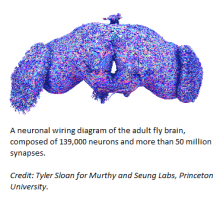An international scientific team unveils a comprehensive neural map of an adult Drosophila melanogaster brain. The BRAIN-funded studies detail more than 50 million connections across 140,000 neurons and appear in nine papers in the journal Nature.
A scientific team supported by the National Institutes of Health (NIH) Brain Research Through Advancing Innovative Neurotechnologies® Initiative, or The BRAIN Initiative® released the first complete map of neural connections in the brain of a female adult fruit fly, a popular research model organism. The study, which details over 50 million connections between more than 140,000 neurons, appears as part of a 9-paper package in the journal Nature.

This monumental scientific achievement lays out the largest and most complete wiring diagram, or “connectome,” of an adult animal brain along with a fly “projectome” that maps all the brain circuits that control the insect’s behavior.
Many genes responsible for human diseases are similar in fruit flies, and its genome is easy to manipulate to study biological processes. This fruit fly connectome serves as a “stepping-stone” to mapping larger-brained mammals and the human brain—helping to bring advanced treatments for brain conditions closer to clinical use.
This work offers critical information about how brains are wired in general, now allowing scientists to study in great detail how the more than 50 million connections that join 140,000 neurons to control fly brain function. Despite its size (that of a poppy seed), the fruit fly brain is a sophisticated biological computer that controls advanced cognitive and behavioral abilities. Fruit flies can form long-term memories, navigate vast distances, and engage in social interactions.
Creating the fly connectome was a huge open science effort. Researchers first sliced the fly brain into thousands of ultrathin sections and used a high-speed electron microscope to generate 21 million images. Other scientists then used a computer program to identify or “segment” thousands of different types of neurons within those images. A large online community of scientific “proofreaders” from fruit fly labs part of the global, open-source FlyWire consortium analyzed the neural segments to ensure accurate labeling. Disseminated through support from the BRAIN Initiative, the FlyWire consortium was thus able to reconstruct the full fly brain connectome.
The newly published research includes open access to downloadable data representing 4,552 cell types and an interactive map that is connected to other fly data resources. Of all the cell types, 3,000 cell types have been independently validated from the hemibrain connectome, and about 1,500 are newly identified cell types.
These papers set the stage for studying more complex brains, including the human brain—accelerating access to future treatments for debilitating brain disorders.
The papers were funded (partially) by: BRAIN Initiative RF1 MH117815, RF1 MH129268, U24 NS126935 and RF1MH120679-01.
References:
Dorkenwald, S., Matsliah, A., Sterling, A. R., Schlegel, P., Yu, S. C., McKellar, C. E., Lin, A., Costa, M., Eichler, K., Yin, Y., Silversmith, W., Schneider-Mizell, C., Jordan, C. S., Brittain, D., Halageri, A., Kuehner, K., Ogedengbe, O., Morey, R., Gager, J., Kruk, K., … FlyWire Consortium. (2024). Neuronal wiring diagram of an adult brain. Nature. https://doi.org/10.1038/s41586-024-07558-y
Schlegel, P., Yin, Y., Bates, A. S., Dorkenwald, S., Eichler, K., Brooks, P., Han, D. S., Gkantia, M., Dos Santos, M., Munnelly, E. J., Badalamente, G., Capdevila, L. S., Sane, V. A., Pleijzier, M. W., Tamimi, I. F. M., Dunne, C. R., Salgarella, I., Javier, A., Fang, S., Perlman, E., … Jefferis, G. S. X. E. (2024). Whole-brain annotation and multi-connectome cell typing quantifies circuit stereotypy in Drosophila. Nature. https://doi.org/10.1038/s41586-024-07686-5
